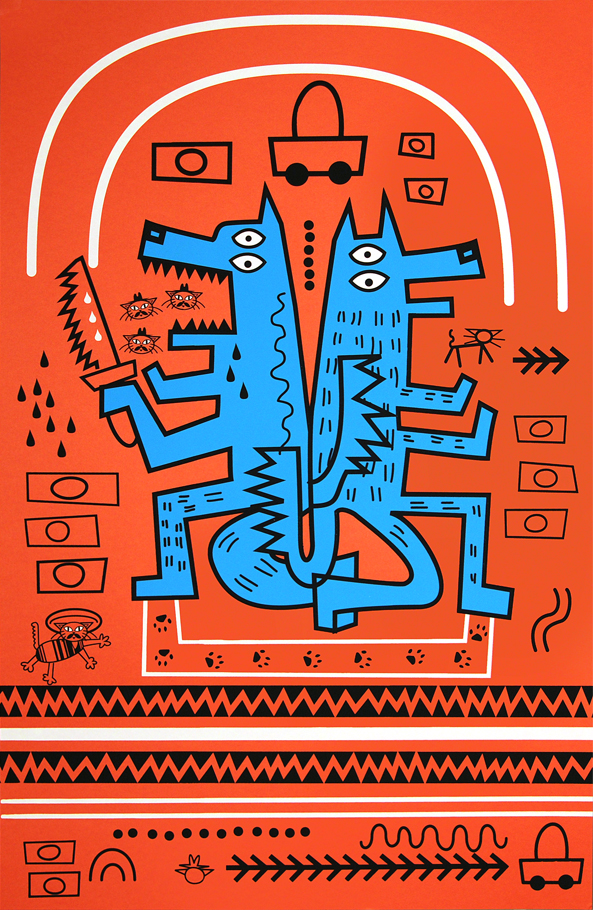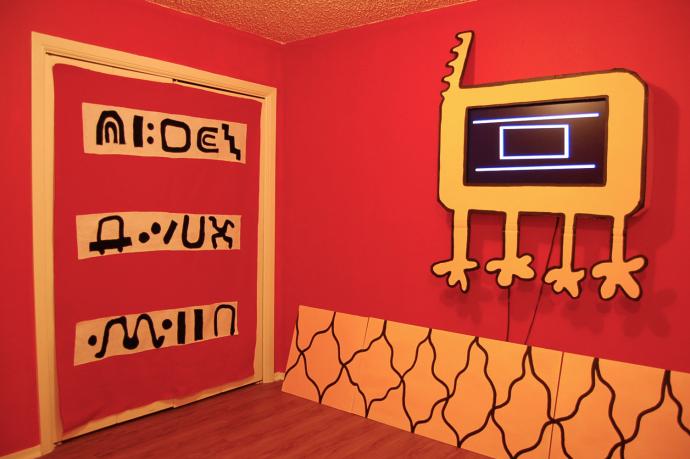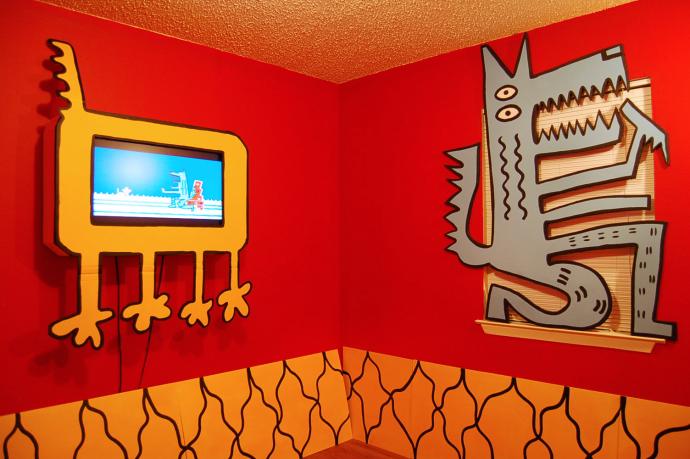from pastelegram.org, June 2011 – April 2014
Michael Menchaca: Of Migratus
The primary objective of Michael Menchaca’s exhibition, Of Migratus, is the interpretation of U.S./Mexico borderland violence and the resulting Mexican diaspora. On view at the Red Space Gallery, the exhibition features a continuation of Menchaca’s serigraphy series Codex Migratus, which appropriates imagery from pre-Hispanic codices to discuss issues of illegal U.S./Mexico immigration, drug cartel violence and human trafficking.

Michael Menchaca, El Coyote, 2010; serigraph; 40 x 20 in,; image courtesy of the artist (work not on display at the Red Space Gallery).
El Coyote, for example, a 2010 serigraph from the Codex Migratus series, presents the ambivalent relationship between coyotes (slang for those who smuggle migrants across the borders) and migrants. Menchaca represents his unnamed immigrants as mustached-cats clad in brightly-colored serapes and sombreros and their human trafficker-counterparts as coyotes. For Of Migratus, Menchaca continues his investigation of the relationship between smuggler and smuggled by extracting his menagerie of icons from the Codex Migratus series and placing them within an immersive sculpture and video installation.
Throughout Menchaca’s works, he creates a writing system comprised of an amalgam of reformed Pre-Hispanic images, logograms and hieroglyphs to catalog the history of the U.S./Mexico border. This pictographic rendering of the border history creates an alternative historical narrative that intertwines pre-Hispanic Mexican history, modern borderland events and American popular culture to create a visual language unique to Menchaca’s Migratus works. In Of Migratus, however, Menchaca extends and experiments with his pictographic vocabulary. Rendering his icons through the new media of sculptural forms and digital animation Menchaca elevates his figures and grants them individual agency. The actions befalling the migrant and coyote act as performed historical records, and thus prompt a more intimate interaction with the viewer, who potentially develops a more vested interest in the figures’ fates and a stronger connection to the reality Menchaca describes.

Michael Menchaca, installation view of Of Migratus, 2012; image courtesy of Red Space Gallery and michaelmenchaca.com.
In the confined one-room installation of Of Migratus is a three-dimensional tableau. The room’s bold red and yellow painted backdrop envelopes the walls and emphasizes a contained viewing and interaction with each of Menchaca’s Migratus animal figures. On the gallery floor corner lays the head of a yellow mustached-cat trailed by tasseled red fabric. Above the cat-head looms an oversized flat rendering of a blue coyote brandishing a serrated-knife.
The installation’s focal point is Menchaca’s new video animation sequence and the television that displays it. A cut-out disembodied feline torso—perhaps the body that originally supported the decapitated cat-head—frames the television, queering this seemingly familiar icon of home life. Playing with the modern notion of television as the new hearth, Menchaca’s looped animation appears as a Saturday morning cartoon replete with retro credits and ambient Muzak. The video animated backdrop Menchaca paints creates an alternate dimension referencing Mixtec and Aztec codices, 8-bit video and puzzle-platformer video games, as well as the character animations of cartoonists Matt Groening and John K.1 Although the brightly-rendered imagery creates an almost nostalgic childhood memory, the subject matter unveils the grisly reality of the immigrant experience through the representations of murders, death and decapitations of Menchaca’s cat figures.

Michael Menchaca, installation view of Of Migratus, 2012; image courtesy of Red Space Gallery and michaelmenchaca.com.
Menchaca’s reliance on popular culture, cartoon pacing and exaggerated stereotypes allows the weighted topics of human trafficking, ethnic displacement and border violence to become digestible and familiar for the viewer. The illogical nature of the animated cartoon itself, as a concept and reality, provides the sardonic styling Menchaca capitalizes on in order to present the Mexican immigrant and their experience into the forefront of a wider discussion on human rights.
Red Space’s Of Migratus success lies in its creation of an alternative dimension that merges such experiences as a domestic setting, historical narrative and a violent crime scene. Menchaca’s historiography of the U.S./Mexico border avoids a melodramatic interpretation of the border and presents a new chapter of technologically-facilitated experimentation that supplements and ultimately enhances the informative perspective of contemporary Latino border art.
- 1. John Kricfalusi (aka John K.) is a prominent animator, cartoonist, and the creator and animator of Nickelodeon’s The Ren and Stimpy Show.